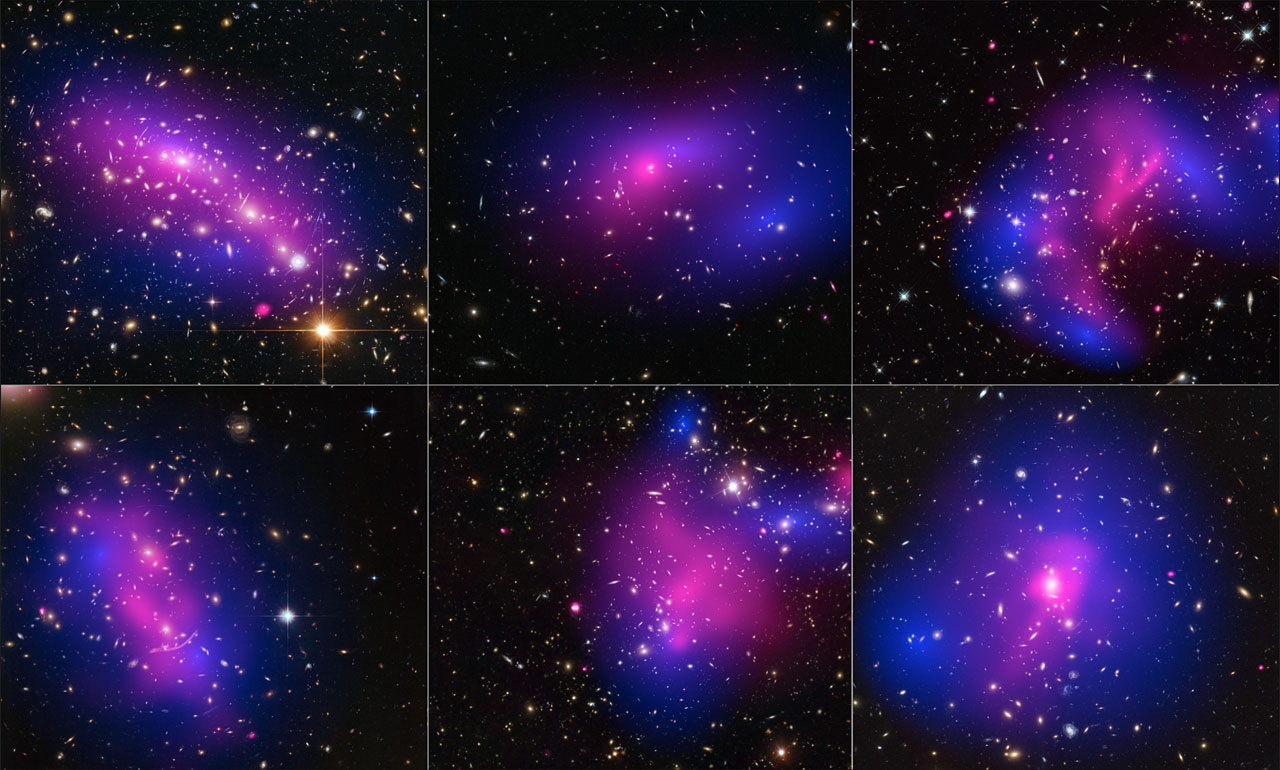That makes it difficult for science - but we can basically learn something about dark matter the same way we originally did with detectable matter - by studying what happens when it bumps into things. But since it is undetectable that can only happen on scales that are really big, like galaxy clusters, where collisions involving dark matter happen and it exists in vast enough quantities to see the effects of collisions. If you want to learn about dark matter, you have to wade into a sea of hot X-ray emitting ionized hydrogen gas.
Galaxies are made of three main ingredients: stars, clouds of gas and then something that we must call dark matter. During collisions, the clouds of gas spread throughout the galaxies crash into each other and slow down or stop while stars are less affected by the drag from the gas, in a similar way to a soap bubble and a bullet in the wind where the bubble would interact a great deal more with the wind than the bullet.

The clusters shown here are, from left to right and top to bottom: MACS J0416.1-2403, MACS J0152.5-2852, MACS J0717.5+3745, Abell 370, Abell 2744, and ZwCl 1358+62. Credit: NASA/ESA/STScI/CXC, D. Harvey (Ecole Polytechnique Federale de Lausanne, Switzerland; University of Edinburgh, UK), R. Massey (Durham University, UK), T. Kitching (University College London, UK), and A. Taylor and E. Tittley (University of Edinburgh, UK
"We know how gas and stars react to these cosmic crashes and where they emerge from the wreckage. Comparing how dark matter behaves can help us to narrow down what it actually is," explains David Harvey of the École Polytechnique Fédérale de Lausanne (EPFL) in Switzerland, lead author of a new study. Harvey and his team used data from the NASA/ESA Hubble Space Telescope and NASA's Chandra X-ray Observatory to study 72 large cluster collisions. The collisions happened at different times, and are seen from different angles — some from the side, and others head-on.
How does that help? The light from galaxies behind the cluster that has been magnified and distorted by the mass in the cluster, with a good idea of the visible mass in the cluster, tells them how much dark matter there must be in a region. Give or take.
The y found that, like the stars, the dark matter continued straight through the violent collisions without slowing down. However, unlike in the case of the stars, this is not because the dark matter is far away from other dark matter during the collisions. The leading theory is that dark matter is spread evenly throughout the galaxy clusters so dark matter particles frequently get very close to each other. The reason the dark matter doesn't slow down is because not only does it not interact with visible particles, it also interacts even less with other dark matter than previously thought.
By finding that dark matter interacts with itself even less than previously thought, the team have successfully narrowed down the properties of dark matter. Theorists will have to keep looking, but at least they now have a smaller set of unknowns to work with.
Article: "The non-gravitational interactions of dark matter in colliding galaxy clusters", upcoming in Science. The international team of astronomers in this study consists of D. Harvey (École Polytechnique Fédérale de Lausanne, Switzerland; University of Edinburgh, UK), R. Massey (Durham University, UK), T. Kitching (University College London, UK), A. Taylor (University of Edinburgh, UK), and E. Tittley (University of Edinburgh, UK).






Comments